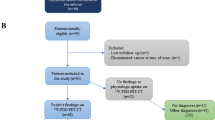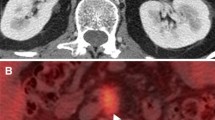Abstract
Purpose
Cancer is still a clinical challenge, with many efforts invested in order to achieve timely detection. Unexplained elevated blood carcinoembryonic antigen levels are occasionally observed in an asymptomatic population and considered as a risk factor of cancers. The purpose of this study was to determine the validity of 18 F-fluorodeoxyglucose-positron emission tomography/computed tomography (F-18 FDG-PET/CT) for detecting cancer in an asymptomatic population with an unexplained elevation in blood carcinoembryonic antigen (CEA) levels.
Methods
This retrospective study included a total of 1920 asymptomatic examinees conducted from August 2011 through September 2013. The participants underwent CEA assay and conventional medical imaging (CEA-conventional), or CEA assay and F-18 FDG-PET/CT (CEA-PET/CT). The validity of conventional medical imaging and CEA-PET/CT scanning for detecting cancer and early-stage cancer in an asymptomatic population with an unexplained elevation in blood CEA levels were evaluated.
Results
Sensitivity, specificity, cancer detection rate, missed cancer detection rate, early-stage cancer detection rate, and early-stage cancer ratio using the CEA-PET/CT scanning were 96.6 %, 100 %, 10.4 %, 0.4 %, 3.7 %, and 34.5 %, respectively. In contrast, the corresponding values obtained using the conventional medical imaging were 50.6 % (P < 0.0001), 100 % (P > 0.9999), 50.6 % (P < 0.0001), 99.9 % (P = 0.055), 2.6 % (P < 0.0001), 2.5 % (P = 0.04), 0.7 % (P = 0.0004), and 14.5 % (P = 0.002), respectively.
Conclusion
The F-18 FDG-PET/CT scanning significantly improved the validity of the cancer detection program in the asymptomatic population with an unexplained elevation in CEA levels.
Similar content being viewed by others

References
Preston DL, Ron E, Tokuoka S, Funamoto S, Nishi N, Soda M, et al. Solid cancer incidence in atomic bomb survivors: 1958–1998. Radiat Res. 2007;168(1):1–64. doi:10.1667/RR0763.1.
Board of Radiation Effects Research DoEaLS, National Research Council of the National Academies. Health Risks from Exposure to Low Levels of Ionizing Radiation: BEIR VII Phase 2. Washington, DC: National Academies Press; 2006.
Leide-Svegborn S. Radiation exposure of patients and personnel from a PET/CT procedure with 18F-FDG. Radiat Prot Dosim. 2010;139(1–3):208–13. doi:10.1093/rpd/ncq026.
Berrington de Gonzalez A, Mahesh M, Kim KP, Bhargavan M, Lewis R, Mettler F, et al. Projected cancer risks from computed tomographic scans performed in the United States in 2007. Arch Intern Med. 2009;169(22):2071–7. doi:10.1001/archinternmed.2009.440.
Brenner DJ, Hall EJ. Computed tomography--an increasing source of radiation exposure. N Engl J Med. 2007;357(22):2277–84. doi:10.1056/NEJMra072149.
Huang B, Law MW, Khong PL. Whole-body PET/CT scanning: estimation of radiation dose and cancer risk. Radiology. 2009;251(1):166–74. doi:10.1148/radiol.2511081300.
Ide M, Suzuki Y. Is whole-body FDG-PET valuable for health screening? For. Eur J Nucl Med Mol Imaging. 2005;32(3):339–41. doi:10.1007/s00259-005-1774-3.
Yasuda S, Ide M, Fujii H, Nakahara T, Mochizuki Y, Takahashi W, et al. Application of positron emission tomography imaging to cancer screening. Br J Cancer. 2000;83(12):1607–11. doi:10.1054/bjoc.2000.1496.
Chen YK, Ding HJ, Su CT, Shen YY, Chen LK, Liao AC, et al. Application of PET and PEt/CT imaging for cancer screening. Anticancer Res. 2004;24(6):4103–8.
Weckesser M, Schober O. Is whole-body FDG-PET valuable for health screening? Against. Eur J Nucl Med Mol Imaging. 2005;32(3):342–3. doi:10.1007/s00259-005-1775-2.
Ghotbi N, Iwanaga M, Ohtsuru A, Ogawa Y, Yamashita S. Cancer screening with whole-body PET/CT for healthy asymptomatic people in Japan: re-evaluation of its test validity and radiation exposure. Asian Pac J Cancer Prev. 2007;8(1):93–7.
Gold P, Freedman SO. Demonstration of Tumor-Specific Antigens in Human Colonic Carcinomata by Immunological Tolerance and Absorption Techniques. J Exp Med. 1965;121:439–62.
Ballesta AM, Molina R, Filella X, Jo J, Gimenez N. Carcinoembryonic antigen in staging and follow-up of patients with solid tumors. Tumour Biol. 1995;16(1):32–41.
Duffy MJ. Carcinoembryonic antigen as a marker for colorectal cancer: is it clinically useful? Clin Chem. 2001;47(4):624–30.
Bates SE. Clinical applications of serum tumor markers. Ann Intern Med. 1991;115(8):623–38.
Slavikova K, Montravers F, Treglia G, Kunikowska J, Kaliska L, Vereb M, et al. What is currently the best radiopharmaceutical for the hybrid PET/CT detection of recurrent medullary thyroid carcinoma? Curr Radiopharm. 2013;6(2):96–105.
Meng X, Huang Z, Wang R, Yu J. Prediction of response to preoperative chemoradiotherapy in patients with locally advanced rectal cancer. Biosci Trends. 2014;8(1):11–23.
Lu YY, Chen JH, Chien CR, Chen WT, Tsai SC, Lin WY, et al. Use of FDG-PET or PET/CT to detect recurrent colorectal cancer in patients with elevated CEA: a systematic review and meta-analysis. Int J Color Dis. 2013;28(8):1039–47. doi:10.1007/s00384-013-1659-z.
Stevens DP, Mackay IR, Cullen KJ. Carcinoembryonic antigen in an unselected elderly population: a four year follow up. Br J Cancer. 1975;32(2):147–51.
Beatty JD, Romero C, Brown PW, Lawrence Jr W, Terz JJ. Clinical value of carcinoembryonic antigen: diagnosis, prognosis, and follow-up of patients with cancer. Arch Surg. 1979;114(5):563–7.
Zamcheck N. Carcinoembryonic antigen. Quantitative variations in circulating levels in benign and malignant digestive tract diseases. Adv Intern Med. 1974;19:413–33.
Dent PB, McCulloch PB, Wesley-James O, MacLaren R, Muirhead W, Dunnett CW. Measurement of carcinoembryonic antigen in patients with bronchogenic carcinoma. Cancer. 1978;42(3 Suppl):1484–91.
Bates SE, Longo DL. Tumor markers: value and limitations in the management of cancer patients. Cancer Treat Rev. 1985;12(3):163–207.
Schoder H, Gonen M. Screening for cancer with PET and PET/CT: potential and limitations. J Nucl Med. 2007;48 Suppl 1:4S–18.
Flamen P, Hoekstra OS, Homans F, Van Cutsem E, Maes A, Stroobants S, et al. Unexplained rising carcinoembryonic antigen (CEA) in the postoperative surveillance of colorectal cancer: the utility of positron emission tomography (PET). Eur J Cancer. 2001;37(7):862–9.
Brenner H, Gefeller O. Variation of sensitivity, specificity, likelihood ratios and predictive values with disease prevalence. Stat Med. 1997;16(9):981–91.
Chen W, Zeng H, Zheng R, Zou X, Zhao P, Wu L, et al. Report of cancer incidence and mortality in china,2010. China Cancer. 2014;23(1):1–10. doi:10.11735/j.issn.1004-0242.2014.01.A001.
Gold P, Freedman SO. Specific carcinoembryonic antigens of the human digestive system. J Exp Med. 1965;122(3):467–81.
Olafsen T, Wu AM. Antibody vectors for imaging. Semin Nucl Med. 2010;40(3):167–81.
Maziak W. Carcinoembryonic antigen (CEA) levels in hookah smokers, cigarette smokers and non-smokers--a comment. J Pak Med Assoc. 2008;58(3):155.
McVicker B, Tuma DJ, Lazure KE, Thomas P, Casey CA. Alcohol, carcinoembryonic antigen processing and colorectal liver metastases. Adv Exp Med Biol. 2015;815:295–311. doi:10.1007/978-3-319-09614-8_17.
Rohren EM, Turkington TG, Coleman RE. Clinical applications of PET in oncology. Radiology. 2004;231(2):305–32. doi:10.1148/radiol.2312021185.
MacMahon H, Austin JH, Gamsu G, Herold CJ, Jett JR, Naidich DP, et al. Guidelines for management of small pulmonary nodules detected on CT scans: a statement from the Fleischner Society. Radiology. 2005;237(2):395–400. doi:10.1148/radiol.2372041887.
Gould MK, Maclean CC, Kuschner WG, Rydzak CE, Owens DK. Accuracy of positron emission tomography for diagnosis of pulmonary nodules and mass lesions: a meta-analysis. JAMA. 2001;285(7):914–24.
Acknowledgments
We thank professor Xincheng Lu (Institute of Genomic Medicine, Wenzhou Medical University, Wenzhou, China), Caicun Zhou (Department of Oncology, Shanghai Pulmonary Hospital, School of Medicine, Tongji University, Shanghai, China), Yi Lu (Department of Radiotherapy, Lihuili Hospital, Ningbo Medical Center, Ningbo, China), Xiaozhong Chen (Department of Radiation Oncology, Zhejiang Cancer Hospital, Hangzhou, China), Weijia Fang (Department of Medical Oncology, First Affiliated Hospital, School of Medicine, Zhejiang University, Hangzhou, China), Zhengyang Xu (Department of Chemo-radiotherapy, People’s Hospital of Yinzhou district, Ningbo, China) and Yuefen Zhou (Department of Oncology, Lishui City Central Hospital, Lishui, China) for helping in data collection. This work was funded in part by the Natural Science Foundation of China (grant no. 81373075, 81371748) and the Science Technology Department of Zhejiang Province of China (grant no.2013C33171).
Author information
Authors and Affiliations
Corresponding authors
Ethics declarations
The study was approved by the ethics committee of the First Affiliated Hospital of Wenzhou Medical University, and all examinees provided a written informed consent.
Conflict of interest
The authors declare that they have no conflicts of interest.
Ethical approval
All procedures performed in studies involving human participants were in accordance with the ethical standards of the institutional and/or national research committee and with the 1964 Helsinki declaration and its later amendments or comparable ethical standards. For this type of study formal consent is not required.
Additional information
Wenfeng Li, Weiwei Yin and Rongying Ou contributed equally to this work.
Electronic supplementary material
Below is the link to the electronic supplementary material.
Supplementary Table 1
(XLSX 11 kb)
Rights and permissions
About this article
Cite this article
Li, W., Yin, W., Ou, R. et al. The value of F-18 fluorodeoxyglucose positron emission tomography/computed tomography in asymptomatic examinees with unexplained elevated blood carcinoembryonic antigen levels. Eur J Nucl Med Mol Imaging 43, 675–681 (2016). https://doi.org/10.1007/s00259-015-3233-0
Received:
Accepted:
Published:
Issue Date:
DOI: https://doi.org/10.1007/s00259-015-3233-0



